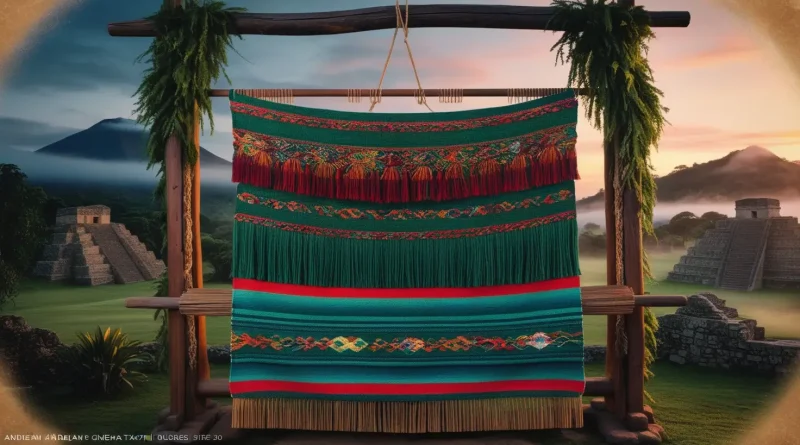Uncuymaza: Exploring the Timeless Art and Tradition of Andean Weaving
Uncuymaza is more than a term; it represents a vibrant cultural heritage woven into the fabric of Andean life. Nestled in the breathtaking Andes Mountains of Peru and Bolivia, Uncuymaza encapsulates a rich tradition of textile art that embodies ancient weaving techniques and storytelling. The roots of this cultural phenomenon reach back to the Inca Empire, a civilization that thrived over 500 years ago and set the foundation for many indigenous practices seen today.
As we delve deeper into the various dimensions of Uncuymaza, we will explore its cultural significance, historical context, and the intricate craftsmanship involved in its creation. This article also highlights the importance of community involvement, the evolution of Uncuymaza in contemporary society, and its potential for environmental sustainability. Through this journey, we uncover how Uncuymaza continues to thrive and adapt, captivating hearts and minds across generations.
The Heart of Andean Identity: Cultural Significance and Symbolism
Uncuymaza is deeply embedded in the cultural psyche of indigenous communities, representing a connection to their ancestors, land, and identity. The textiles created through Uncuymaza are not merely functional items; they are imbued with spiritual symbolism and meanings that resonate within the community. For instance, motifs depicting natural elements such as mountains, rivers, and animals serve as reminders of the sacred relationship between the Andean peoples and their environment. These designs, rich in mythological symbols, reflect the values and beliefs that have been passed down through generations, often illustrating agricultural cycles, spiritual journeys, and community rituals.
The importance of Uncuymaza goes beyond aesthetics; it fosters a sense of belonging and continuity within the community. The vibrant colors and intricate patterns often made from natural fibers and dyes are expressions of cultural pride, showcasing the artisans’ skills and dedication. Community festivals and cultural rituals that celebrate Uncuymaza reinforce this sense of identity, bringing people together to honor their heritage and share their stories. As these traditions evolve, they adapt to modern influences while maintaining their core significance, ensuring that Uncuymaza remains a living tradition.
Tracing the Threads of Time: Historical Context of Uncuymaza
The history of Uncuymaza dates back to the Inca Empire, which flourished between the 15th and 16th centuries. During this time, the Incas developed advanced weaving techniques that laid the groundwork for the practices we see today. They utilized the backstrap loom, a simple yet ingenious device that allowed artisans to create intricate textiles from llama wool, a vital resource in Andean culture. This technique, combined with knowledge passed down through generations, has kept the spirit of Uncuymaza alive for centuries.
You May Also Like: Lwedninja: Your Pathway to Personal Growth and Professional Success – Picuki
Throughout the colonial period, Uncuymaza faced challenges as foreign influences threatened to overshadow indigenous practices. However, the resilience of the Andean communities ensured the survival of these traditions. In the late 20th century, there was a resurgence of interest in indigenous crafts, driven by a broader movement towards cultural preservation and sustainable practices. Today, Uncuymaza is celebrated not only for its artistic value but also for its role in reinforcing indigenous identity and advocating for environmental conservation.
Artistry in Motion: Traditional Techniques in Weaving
At the core of Uncuymaza is the mastery of traditional weaving techniques, particularly those employed with the backstrap loom. This ancient tool allows artisans to weave textiles by utilizing the tension of their bodies and the loom itself. The process requires a high degree of skill and patience, often taking weeks or months to complete a single piece. Artisans use natural fibers, such as llama and alpaca wool, which are known for their durability and warmth, making them ideal for the region’s climate.
The art of Uncuymaza extends beyond mere technique; it involves a deep understanding of the materials and processes involved. Artisans often source their fibers locally, employing natural dyeing methods that utilize plants, minerals, and even insects to create vibrant hues. This commitment to using sustainable resources highlights the cultural significance of Uncuymaza, as each textile becomes a testament to the artisan’s connection to the land and their heritage. Through community workshops, artisans share their skills with younger generations, ensuring that these traditional techniques continue to flourish.
| Traditional Weaving Techniques | Materials Used | Dyeing Methods |
| Backstrap loom | Llama wool | Plant-based dyes |
| Hand-spinning | Alpaca fiber | Mineral-based dyes |
| Knotting and braiding | Cotton | Insect-based dyes |
Woven Narratives: Symbolism in Uncuymaza Designs
The designs within Uncuymaza textiles serve as intricate narratives, each telling a unique story about the community and its values. The use of textile motifs often reflects aspects of Andean life, such as agricultural practices and mythological tales. For instance, patterns depicting maize or potatoes symbolize fertility and abundance, while others may represent spiritual journeys or ancestral connections. This deep symbolism creates a profound bond between the weaver and their work, transforming textiles into vessels of history and culture.
Moreover, the significance of these designs extends beyond the individual artisan, permeating the broader community. When worn or displayed, these textiles become a source of pride and identity for the entire community. Festivals and ceremonies often feature these woven narratives prominently, allowing participants to connect with their heritage while sharing it with others. This collective storytelling reinforces social bonds and highlights the importance of preserving the cultural narratives embedded within Uncuymaza.
Strength in Unity: Community Involvement in Uncuymaza
Community involvement plays a crucial role in sustaining the traditions of Uncuymaza. Artisans often gather in cooperatives or community groups, where they share techniques, stories, and support one another in their craft. This collaborative spirit fosters a sense of belonging and helps ensure that the skills and knowledge required to create Uncuymaza textiles are passed down through generations. Workshops and community events provide spaces for learning, creativity, and cultural exchange, making Uncuymaza a living tradition.
Local leaders and organizations also advocate for the recognition of Uncuymaza as an essential part of Andean culture. By promoting community festivals and cultural celebrations, they help raise awareness of the significance of these traditions both locally and globally. This engagement not only supports the artisans economically but also strengthens cultural identity, encouraging younger generations to embrace their heritage. As Uncuymaza continues to evolve, the commitment of the community ensures its vitality and relevance.
Celebrating Heritage: Rituals and Ceremonies Surrounding Uncuymaza
Rituals and ceremonies surrounding Uncuymaza are vital to its cultural significance, providing opportunities for the community to come together in celebration. Events such as harvest festivals play a crucial role in honoring the earth and expressing gratitude for the resources it provides. During these celebrations, participants often wear traditional textiles, showcasing the artistry of Uncuymaza while engaging in music, dance, and storytelling. These gatherings foster a sense of unity and reinforce the importance of community heritage.
Ceremonial structures, often built for specific rituals, serve as physical representations of the cultural significance of Uncuymaza. These spaces are designed to facilitate community gatherings, allowing for shared experiences that strengthen social bonds. Through these rituals, the stories and meanings behind Uncuymaza are not only preserved but also celebrated, ensuring that they remain a vital part of community life. As these traditions evolve, they continue to inspire new generations to engage with their cultural roots.
| Celebration | Key Activities | Cultural Significance |
| Harvest Festival | Music, dance, textile displays | Honors agricultural abundance |
| Community Gatherings | Storytelling, workshops | Strengthens community bonds |
| Ceremonial Events | Rituals, offerings | Connects to spiritual beliefs |
Embracing Change: Modern Adaptations of Uncuymaza
In an ever-changing world, Uncuymaza has shown remarkable adaptability, integrating contemporary influences while preserving its traditional essence. Modern artisans are reinterpreting ancient techniques and motifs to create textiles that resonate with today’s ethical fashion industry. This evolution not only appeals to a wider audience but also promotes sustainable practices, as these artisans prioritize eco-friendly materials and methods.
You May Also Like: Transform Your Mobile Home with https// mobilehomeexteriors.com: Ultimate Guide to Upgrades and Renovations – Picuki
As interest in sustainable fashion grows, Uncuymaza textiles are gaining recognition on global platforms, allowing artisans to share their craft with new markets. The digital age has opened doors for online sales and marketing, enabling artisans to reach customers far beyond their local communities. By embracing modern tools and trends, Uncuymaza continues to thrive, ensuring that its rich cultural heritage remains relevant in a contemporary context.
Learning through Weaving: Educational Impact of Uncuymaza
Uncuymaza serves as an educational tool, fostering personal growth and cultural understanding among participants. Weaving workshops not only teach the technical skills necessary to create textiles but also emphasize the importance of cultural narratives. Engaging with Uncuymaza helps individuals develop critical thinking skills, patience, and appreciation for their heritage, which are invaluable traits in today’s fast-paced world.
The educational benefits of Uncuymaza extend beyond individual development; they also contribute to cultural preservation. By involving younger generations in the weaving process, communities can ensure that these vital skills and stories are not lost. This intergenerational knowledge transfer strengthens community ties and nurtures a sense of pride in cultural heritage, encouraging future artisans to continue the legacy of Uncuymaza.
| Educational Benefits | Skills Developed | Cultural Knowledge Gained |
| Understanding traditional techniques | Weaving skills | Insights into indigenous culture |
| Building patience and focus | Craftsmanship | Knowledge of historical narratives |
| Fostering community connections | Teamwork and collaboration | Appreciation for sustainable practices |
Greener Tomorrow: Environmental Sustainability and Uncuymaza
Uncuymaza embodies principles of environmental sustainability that align with modern conservation efforts. Traditional artisans utilize natural fibers, such as llama and alpaca wool, and dyes derived from local plants, minimizing the ecological impact of textile production. This commitment to sustainable practices not only supports environmental conservation but also preserves the unique biodiversity of the Andean region.
By maintaining a symbiotic relationship with nature, the artisans of Uncuymaza demonstrate the importance of ecological stewardship. Their practices, such as terrace farming, have been recognized as effective methods for conserving soil and water resources in the rugged Andean terrain. As communities increasingly adopt these sustainable practices, Uncuymaza not only survives but thrives as a model of how traditional knowledge can inform contemporary environmental efforts.
| Sustainable Practices | Environmental Benefits | Community Impact |
| Use of natural dyes and fibers | Reduced pollution | Strengthened local economies |
| Preservation of biodiversity | Conservation of local flora and fauna | Enhanced community resilience |
| Eco-friendly production techniques | Sustainable land use | Education on environmental practices |
Cultural Waves: Uncuymaza in Popular Culture
The influence of Uncuymaza has extended into popular culture, appearing in various forms of media and art. Documentaries and fashion showcases often highlight the artistry of Andean weavers, bringing Uncuymaza to a global audience. The intricate patterns and rich histories associated with Uncuymaza are celebrated in art exhibitions, allowing viewers to engage with the culture on a deeper level.
Moreover, the resurgence of interest in ethical fashion has positioned Uncuymaza as a source of inspiration for contemporary designers. Fashion shows featuring Uncuymaza textiles not only promote the artistry of indigenous artisans but also emphasize the importance of sustainable and ethical production methods. This intersection of traditional craftsmanship and modern fashion highlights the ongoing relevance of Uncuymaza in today’s cultural landscape.
| Media Representations | Cultural Impact | Global Recognition |
| Documentaries showcasing artisans | Increased awareness of indigenous culture | Awards and accolades for craftsmanship |
| Fashion shows featuring Uncuymaza textiles | Promotion of ethical fashion | Collaborations with international designers |
| Art exhibitions celebrating textile art | Fostering appreciation for tradition | Strengthened cultural pride |
Global Reach: Uncuymaza’s Influence Across Borders
Uncuymaza has transcended its geographical roots, becoming a symbol of cultural exchange on a global scale. As indigenous practices gain recognition in the context of globalization, Uncuymaza serves as a powerful example of how traditional wisdom can inform contemporary issues. The narratives and values associated with Uncuymaza resonate with diverse audiences, fostering understanding and appreciation for different cultures.
The dialogue surrounding Uncuymaza promotes connections between communities, allowing for the exchange of ideas and practices. This cultural interplay enriches both the origin communities and those who engage with Uncuymaza, creating a shared sense of heritage that transcends borders. As the world becomes more interconnected, the importance of cultural narratives like Uncuymaza cannot be overstated, as they provide valuable insights into the complexities of identity and belonging.
Looking Ahead: The Future of Uncuymaza
The future of Uncuymaza appears bright, with increasing interest in its cultural significance and artisanal practices. As more people seek to engage with sustainable fashion and ethical consumerism, Uncuymaza can emerge as a beacon of inspiration. Contemporary artisans are likely to continue blending traditional techniques with modern designs, ensuring that Uncuymaza remains relevant and appealing to new generations.
You May Also Like: Tech Etruesports: Redefining Competitive Gaming in the Digital Age – Picuki
Furthermore, as technology continues to advance, opportunities for digital engagement will expand. Online platforms can facilitate connections between artisans and global audiences, allowing for greater visibility and appreciation of Uncuymaza textiles. However, it is crucial that as Uncuymaza evolves, its cultural integrity is maintained, striking a balance between innovation and tradition.
| Future Prospects | Potential Developments | Community Involvement |
| Growth in sustainable fashion | Collaborations with global designers | Training programs for young artisans |
| Increased digital engagement | Virtual workshops and exhibitions | Community-led cultural events |
| Expanding markets for Uncuymaza textiles | Fair trade initiatives | Strengthening local economies |
Celebrating Traditions: Community Festivals of Uncuymaza
Community festivals are integral to the celebration of Uncuymaza, bringing together individuals to honor their cultural heritage. Events such as harvest festivals and textile fairs serve as platforms for showcasing Uncuymaza craftsmanship, offering opportunities for artisans to sell their work and share their stories. These gatherings are characterized by vibrant displays of textiles, traditional music, and dance, creating an immersive cultural experience for participants and visitors alike.
During these festivals, the spirit of Uncuymaza comes alive, reinforcing social bonds and fostering a sense of belonging within the community. Participants often engage in activities that highlight the importance of their heritage, such as storytelling and traditional games. As these festivals grow in popularity, they attract attention from tourists and cultural enthusiasts, further promoting the significance of Uncuymaza as a vital aspect of Andean identity.
Unearthing the Past: Archaeological Significance of Uncuymaza
The archaeological significance of Uncuymaza lies in its connection to the rich history of the Andean region. Excavations and studies have revealed ancient artifacts and ceremonial structures linked to textile production, shedding light on the daily lives and beliefs of past societies. These findings offer invaluable insights into the techniques and materials used by the Incas and other indigenous groups, allowing researchers to trace the evolution of Uncuymaza over time.
As new archaeological discoveries emerge, they enhance our understanding of how Uncuymaza shaped the social and cultural dynamics of the Andean people. The preservation of historical sites and artifacts is crucial to safeguarding this legacy, ensuring that future generations can appreciate the artistry and significance of Uncuymaza within their cultural narrative.
Navigating Challenges: The Modern-Day Struggles of Uncuymaza
Despite its rich heritage, Uncuymaza faces numerous challenges in the contemporary world. Cultural erosion, environmental degradation, and economic pressures threaten the survival of traditional practices. As globalization continues to influence indigenous communities, it is essential to strike a balance between embracing modernity and preserving cultural identity.
Efforts to protect Uncuymaza involve community-led initiatives aimed at promoting awareness and education about the importance of these traditions. Cultural festivals, workshops, and outreach programs play a vital role in fostering appreciation for Uncuymaza, encouraging both locals and visitors to engage with the craft and its significance. By addressing these challenges collectively, communities can ensure that Uncuymaza remains a vibrant and integral part of their cultural landscape.
Experiencing Uncuymaza: Engaging with Culture and Tradition
For those interested in experiencing Uncuymaza firsthand, numerous opportunities await. Participating in local workshops allows individuals to learn weaving techniques directly from artisans, fostering a deeper connection to the craft. Additionally, visiting cultural festivals provides a unique glimpse into the vibrant traditions surrounding Uncuymaza, offering an immersive experience filled with music, dance, and storytelling.
Travelers seeking to engage with Uncuymaza can also explore the Andean region’s breathtaking landscapes, where the artistry and culture are deeply rooted. By supporting local artisans and participating in community events, visitors can contribute to the preservation of these traditions while enriching their understanding of the rich cultural heritage that defines Uncuymaza.
The Value of Tradition: Intergenerational Knowledge Transfer in Uncuymaza
Intergenerational knowledge transfer is vital to the preservation of Uncuymaza. Elders within the community play a crucial role in passing down techniques, stories, and cultural values to younger generations. This process not only ensures that traditional practices continue but also strengthens the bonds between family members and the broader community. By teaching their children and grandchildren, artisans help instill an appreciation for the cultural heritage that has shaped their lives and their identity.
Storytelling is a key element of this knowledge transfer, allowing elders to share the historical and spiritual significance of Uncuymaza. When younger individuals engage with these narratives, they gain a sense of pride and responsibility, understanding the importance of carrying forward these traditions. This connection empowers them to honor the legacy of Uncuymaza while potentially adapting its practices to align with modern contexts, ensuring that this cultural treasure remains relevant across generations.
Conclusion
Uncuymaza is a testament to the resilience and richness of Andean culture, representing centuries of craftsmanship, community, and continuity. This unique form of textile art goes beyond aesthetics, serving as a symbol of cultural identity and a means of preserving invaluable knowledge and stories passed down through generations. Through modern adaptations and increasing global awareness, Uncuymaza continues to inspire, engaging audiences worldwide who recognize the importance of sustainable, ethical practices.
Today, as the world becomes more interconnected, Uncuymaza serves as a reminder of the beauty in diversity and the power of tradition. By embracing Uncuymaza, we honor not only the Andean artisans who keep these traditions alive but also the broader concept of cultural preservation. As we celebrate this ancient craft, we can look forward to a future where Uncuymaza continues to thrive, fostering a spirit of pride, resilience, and unity within the Andean community and beyond.
Frequently Asked Questions(FAQs)
What is the significance of Uncuymaza in Andean culture?
Uncuymaza represents the heart of Andean cultural identity, symbolizing their connection to the land, spirituality, and ancestral heritage. The textiles and motifs capture stories, beliefs, and traditions passed down through generations.
How are Uncuymaza textiles made?
Uncuymaza textiles are crafted using traditional weaving techniques, such as the backstrap loom. Artisans use natural fibers and dyes, creating intricate patterns that often carry symbolic meanings connected to nature, myths, and cultural narratives.
What role does Uncuymaza play in sustainability?
Uncuymaza promotes sustainability through its eco-friendly production methods.
Can people experience Uncuymaza firsthand?
Yes, travelers can experience Uncuymaza by attending community festivals, participating in workshops, or visiting the Andes. Engaging with local artisans offers an authentic perspective on this unique cultural tradition.
Why is Uncuymaza relevant today?
Uncuymaza remains relevant by adapting to contemporary interests in ethical fashion and cultural preservation. Its emphasis on sustainability and community engagement resonates with global audiences, ensuring its continued appreciation and influence.




